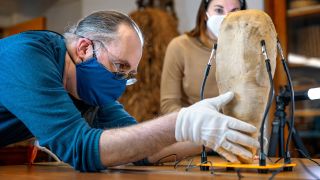Ancient Egyptian mummy forgotten in storage turns out to be sacred bird often sacrificed to Thoth
By Callum McKelviepublished about 15 hours ago
The bird may be an Ibis, often sacrificed by the ancient Egyptians to the god Thoth.

An ancient Egyptian bird mummy, long forgotten in storage and mislabeled as a hawk, is finally getting its due now that researchers have digitally peered inside its wrappings.
The 1,500-year-old mummy, scientists learned, is not a hawk but likely a sacred ibis (Threskiornis aethiopica) — a wading bird with stilt-like legs and a long curved beak that the ancient Egyptians often sacrificed to Thoth, the god of the moon, reckoning, learning and writing.
"Not only was this once a living creature that people of the day may have enjoyed watching stroll through the water," Carol Ann Barsody, a masters student in archaeology at Cornell University, who spearheaded the project, said in a statement. "It also was, and is, something sacred, something religious."
Cornell University has no record of the mummy's arrival into its collections. Barsody initially suspected that the mummy arrived as part of an 1884 freight of objects, which included the human mummy Penpi, a Thebian scribe. However, after doing further research, she discovered that no other Egyptian artifacts arrived with Penpi.Sent from my Linux system.
No comments:
Post a Comment